The Spiritual Nature of the Soul
Swami Prabhupada, the founder of the Krishna movement in the West, gives here the view of the Vedic scriptures, the original Indian yoga philosophy. According to it, the soul is non-material, immortal and present in every living being, even in every atom.
Human life is attained after many, many millions of years of evolution. We should remember that according to the Padma Purāṇa, there are 8,400,000 species of life. Life began with the water beings, because we can understand from the Vedic literature that in the beginning of creation the whole planet was submerged under water.
The material world is composed of five gross elements – earth, water, fire, air and ether. Besides these, there are three subtle elements – spirit, intelligence and ego. Behind these curtains is the spiritual soul, which is covered by these eight elements. We get this information from the Bhagavad-gītā.
Human beings are not the only living beings who have spiritual souls. We are all spiritual souls – mammals, birds, reptiles, insects, trees, plants, water beings and so on. The spiritual soul is only covered by different clothes, just as some of you wear white clothes, others green, and some red. But we are not concerned with the clothes; we are concerned with you as the spiritual soul. In the Bhagavad-gītā (5.18) it says:
vidyā-vinaya-sampanne
brāhmaṇe gavi hastini
śuni caiva śvapāke ca
paṇḍitāḥ sama-darśinaḥ
“The humble sage, by virtue of true knowledge, sees a learned and kind brāhmana, a cow, an elephant, a dog, and a dog-eater with equal eyes.”
Swami Prabhupada, the founder of the Krishna movement in the West, gives here the view of the Vedic scriptures, the original Indian yoga philosophy. According to it, the soul is non-material, immortal and present in every living being, even in every atom.
Human life is attained after many, many millions of years of evolution. We should remember that according to the Padma Purāṇa, there are 8,400,000 species of life. Life began with the water beings, because we can understand from the Vedic literature that in the beginning of creation the whole planet was submerged under water.
The material world is composed of five gross elements – earth, water, fire, air and ether. Besides these, there are three subtle elements – spirit, intelligence and ego. Behind these curtains is the spiritual soul, which is covered by these eight elements. We get this information from the Bhagavad-gītā.
Human beings are not the only living beings who have spiritual souls. We are all spiritual souls – mammals, birds, reptiles, insects, trees, plants, water beings and so on. The spiritual soul is only covered by different clothes, just as some of you wear white clothes, others green, and some red. But we are not concerned with the clothes; we are concerned with you as the spiritual soul. In the Bhagavad-gītā (5.18) it says:
vidyā-vinaya-sampanne
brāhmaṇe gavi hastini
śuni caiva śvapāke ca
paṇḍitāḥ sama-darśinaḥ
“The humble sage, by virtue of true knowledge, sees a learned and kind brāhmana, a cow, an elephant, a dog, and a dog-eater with equal eyes.”
This text is taken from: A. C. Bhaktivedanta Swami Prabhupada: The Beauty of the Self, Bhaktivedanta Book Trust, 1988, pp. 214-217.
The sage makes no distinctions on the basis of skin color, intelligence, or life form. He sees every living being as a tiny spiritual particle.
It is called:
kesāgra-śata-bhāgasya
śatāṁśaḥ sādṛśātmakaḥ
jīvaḥ sūkṣma-svarūpo ‘yam
saṅkhyātīto hi cit-kaṇaḥ
“There are innumerable particles of spiritual atoms measuring one ten-thousandth of the tip of a hair.”
Because we have no instrument to measure the dimensions of the spiritual soul, the small particle of the spiritual soul is defined in this way. In other words, the soul is so small that it is smaller than an atom. This small particle is in you, is in me, in the elephant, in gigantic animals, in all human beings, in the ant, in the tree, everywhere. However, scientific knowledge cannot calculate the dimensions of the soul; nor can a doctor determine the soul in the body. Consequently, material scientists conclude that there is no soul. But this is not so. There is a soul. The presence of the soul makes the difference between a living body and a dead body. As soon as the soul leaves the body, the body dies. It has no more value. One may be a great scientist or philosopher, but one must admit that the body dies as soon as the soul leaves the body. Then the body has no more value and is taken away. We should understand this. The soul is valuable, not the body. The fact that the soul migrates is explained in the Bhagavad-gītā (2.22):
vāsāṁsi jīrṇāni yathā vihāya
navāni gṛhṇāti naro ‘parāṇi
tathā śarīrāṇi vihāya jīrṇāny
anyāni saṁyāti navāni dehī
“Just as someone puts on new clothes and takes off the old ones, the soul takes on new material bodies and gives up the ones that have become old and useless.” When a suit becomes old, we discard it and put on another; similarly, the soul changes clothes according to its desire. Because the soul is a tiny component of God, it has divine attributes. God is the supreme will, the supreme power, the supreme independent, and we, who are tiny components of Him, have all these qualities in tiny quantities. We have a will, thoughts, feelings and desires. In the Vedas, it is said that God is the supreme life force among all life forces (cetanaś cetanānam). He also takes care of the necessities of all living beings.
We living beings are innumerable; our number has no limit. God, however, is one. He is also alive like us, but we are tiny particles of that life force. For example, a particle of gold has the same characteristics as the gold in the mine.
If we chemically examine the components of a tiny drop of water, we will find that the same components are found in the ocean. Similarly, we are one with God because we are His tiny constituents. This divine particle, the soul or life force, moves from water creatures to trees and plants, from trees and plants to insects, then to reptiles, then to birds and mammals, and finally to human bodies. Darwin’s theory of evolution is only a partial explanation of transmigration. Darwin only took some information from the Vedic literature, but he has no concept of the soul. The difference is that the soul moves from water life to plants and trees, then to insect life, then to bird life, then to mammal life, then to human life, and within human life it moves from uncivilized life to civilized life and so on. The civilized life of a human being represents the culmination of evolution. Here is the crossroads: from here we can slip back into the cycle of evolution, or we can rise to divine life. We have the choice. This is indicated in the Bhagavad-gītā.
The human form of life basically means evolved consciousness; therefore, we should not waste our lives like cats, dogs and pigs. This is the instruction. Although our body is as perishable as that of a dog or cat, it differs in that with it one can attain the highest perfection of life. We are tiny components of God, but in some way we have fallen into material existence. Now we have to evolve so that we can return home, to God. That is the highest perfection.
There is actually another world, a spiritual world. In the Bhagavad-gītā (8.20) it says in this regard:
paras tasmāt tu bhāvo ‘nyo
‘vyakto ‘vyaktāt sanātanaḥ
yaḥ sa sarveṣu bhūteṣu
naśyatsu na vinaśyati
“Yet there is another nature which is eternal and transcendental to this manifested and unmanifested matter. It is the supreme and will never be annihilated. When everything in this world is annihilated, that part remains as it is.”
In material nature, everything is created, persists for a time, produces by-products, dwindles, and finally passes away. Our bodies are created at a certain time through sexual intercourse; the father’s seed combines with the mother’s egg, whereupon a pea-shaped structure is formed in which the living being or soul seeks refuge, and because it seeks refuge there, it develops hands, eyes, and so on. This development is completed in seven months, and in the ninth month, the human being comes out of the womb. It is due to the presence of the soul that the child develops. If the soul is not present, there is no development and the child is born dead. We can take this dead body and preserve it chemically, but it will not develop. Development means change of the body. We all had baby bodies, but those bodies no longer exist.
The body of an infant develops into the body of a child, and that body develops into the body of a boy, and that body develops into the body of a teenager, which finally becomes the body of an old man. In the end, the body disappears completely. The entire cosmic manifestation, the gigantic form of this material world, works on the same principle. It is created at a certain point, evolves, is sustained, and dissolves at a certain point. That is the nature of the material world. It is manifested at certain intervals and passes away (bhūtvā pralīyate).
The word bhāva means “nature.” There is another nature that never dissolves, that is eternal. As jivas, or spiritual souls, we are also eternal.
This is confirmed in the Bhagavad-gītā (2.20):
na jāyate mriyate vā kadācin
nāyaṁ bhūtvā bhavitā vā na bhūyaḥ
ajo nityaḥ śāśvato ‘yaṁ purāṇo
na hanyate hanyamāne śarīre
“For the soul there is neither birth nor death. Nor does it, having once been, ever cease to be. It is unborn, eternal, everlasting, immortal, and primordial. It is not slain when the body is slain.”
Just as God knows neither birth nor death, so for us spiritual souls there can be neither birth nor death; but because we think “I am the body,” we think we will be born and die. Such thinking is called māyā, or illusion, and once we get out of this illusion of identifying the soul with the body, we reach the stage called brahma-bhūta. When one realizes ahaṁ brahmāsmi, “I am not this body, but a spiritual soul, a minute component of the Supreme Brahman,” one attains what is called Brahman-realization. Once one attains Brahman realization, one becomes happy.
This article was originally published on the German website: Seele, Körper und Befreiung in der Bhagavad-gītā




